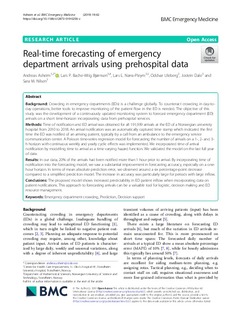| dc.contributor.author | Asheim, Andreas | |
| dc.contributor.author | Bjørnsen, Lars Petter Bache-Wiig | |
| dc.contributor.author | Næss-Pleym, Lars Eide | |
| dc.contributor.author | Uleberg, Oddvar | |
| dc.contributor.author | Dale, Jostein | |
| dc.contributor.author | Nilsen, Sara Marie | |
| dc.date.accessioned | 2020-02-11T10:17:52Z | |
| dc.date.available | 2020-02-11T10:17:52Z | |
| dc.date.created | 2019-09-26T10:52:51Z | |
| dc.date.issued | 2019 | |
| dc.identifier.citation | BMC Emergency Medicine. 2019, 19 (42), 1-6. | nb_NO |
| dc.identifier.issn | 1471-227X | |
| dc.identifier.uri | http://hdl.handle.net/11250/2640979 | |
| dc.description.abstract | Background: Crowding in emergency departments (EDs) is a challenge globally. To counteract crowding in day-to-day operations, better tools to improve monitoring of the patient flow in the ED is needed. The objective of this study was the development of a continuously updated monitoring system to forecast emergency department (ED)arrivals on a short time-horizon incorporating data from prehospital services. Methods: Time of notification and ED arrival was obtained for all 191,939 arrivals at the ED of a Norwegian university hospital from 2010 to 2018. An arrival notification was an automatically captured time stamp which indicated the first time the ED was notified of an arriving patient, typically by a call from an ambulance to the emergency service communication center. A Poisson time-series regression model for forecasting the number of arrivals on a 1-, 2- and 3-h horizon with continuous weekly and yearly cyclic effects was implemented. We incorporated time of arrival notification by modelling time to arrival as a time varying hazard function. We validated the model on the last full year of data. Results: In our data, 20% of the arrivals had been notified more than 1 hour prior to arrival. By incorporating time of notification into the forecasting model, we saw a substantial improvement in forecasting accuracy, especially on a one-hour horizon. In terms of mean absolute prediction error, we observed around a six percentage-point decrease compared to a simplified prediction model. The increase in accuracy was particularly large for periods with large inflow. Conclusions: The proposed model shows increased predictability in ED patient inflow when incorporating data on patient notifications. This approach to forecasting arrivals can be a valuable tool for logistic, decision making and ED resource management. | nb_NO |
| dc.language.iso | eng | nb_NO |
| dc.publisher | BMC | nb_NO |
| dc.rights | Navngivelse 4.0 Internasjonal | * |
| dc.rights.uri | http://creativecommons.org/licenses/by/4.0/deed.no | * |
| dc.title | Real-time forecasting of emergency department arrivals using prehospital data | nb_NO |
| dc.type | Journal article | nb_NO |
| dc.type | Peer reviewed | nb_NO |
| dc.description.version | publishedVersion | nb_NO |
| dc.source.pagenumber | 1-6 | nb_NO |
| dc.source.volume | 19 | nb_NO |
| dc.source.journal | BMC Emergency Medicine | nb_NO |
| dc.source.issue | 42 | nb_NO |
| dc.identifier.doi | 10.1186/s12873-019-0256-z | |
| dc.identifier.cristin | 1729401 | |
| dc.relation.project | Norges forskningsråd: 256579 | nb_NO |
| dc.description.localcode | © The Author(s). 2019Open AccessThis article is distributed under the terms of the Creative Commons Attribution 4.0International License (http://creativecommons.org/licenses/by/4.0/), which permits unrestricted use, distribution, andreproduction in any medium, provided you give appropriate credit to the original author(s) and the source, provide a link tothe Creative Commons license, and indicate if changes were made. The Creative Commons Public Domain Dedication waiver(http://creativecommons.org/publicdomain/zero/1.0/) applies to the data made available in this article, unless otherwise stated. | nb_NO |
| cristin.unitcode | 1920,26,0,0 | |
| cristin.unitcode | 194,63,15,0 | |
| cristin.unitcode | 194,65,25,0 | |
| cristin.unitcode | 1920,29,0,0 | |
| cristin.unitname | Sentral stab | |
| cristin.unitname | Institutt for matematiske fag | |
| cristin.unitname | Institutt for sirkulasjon og bildediagnostikk | |
| cristin.unitname | Klinikk for akutt- og mottaksmedisin | |
| cristin.ispublished | true | |
| cristin.fulltext | original | |
| cristin.qualitycode | 1 | |

